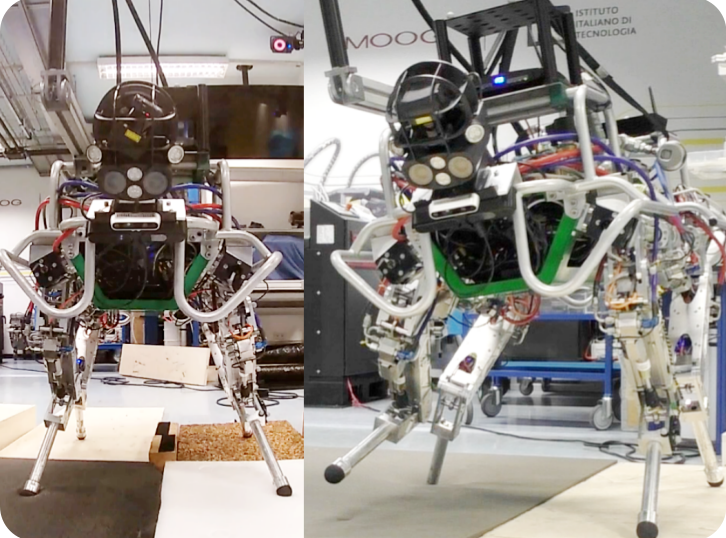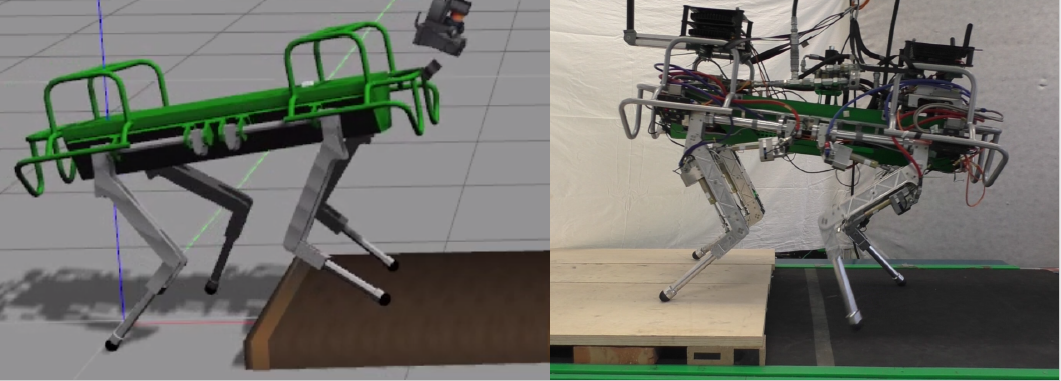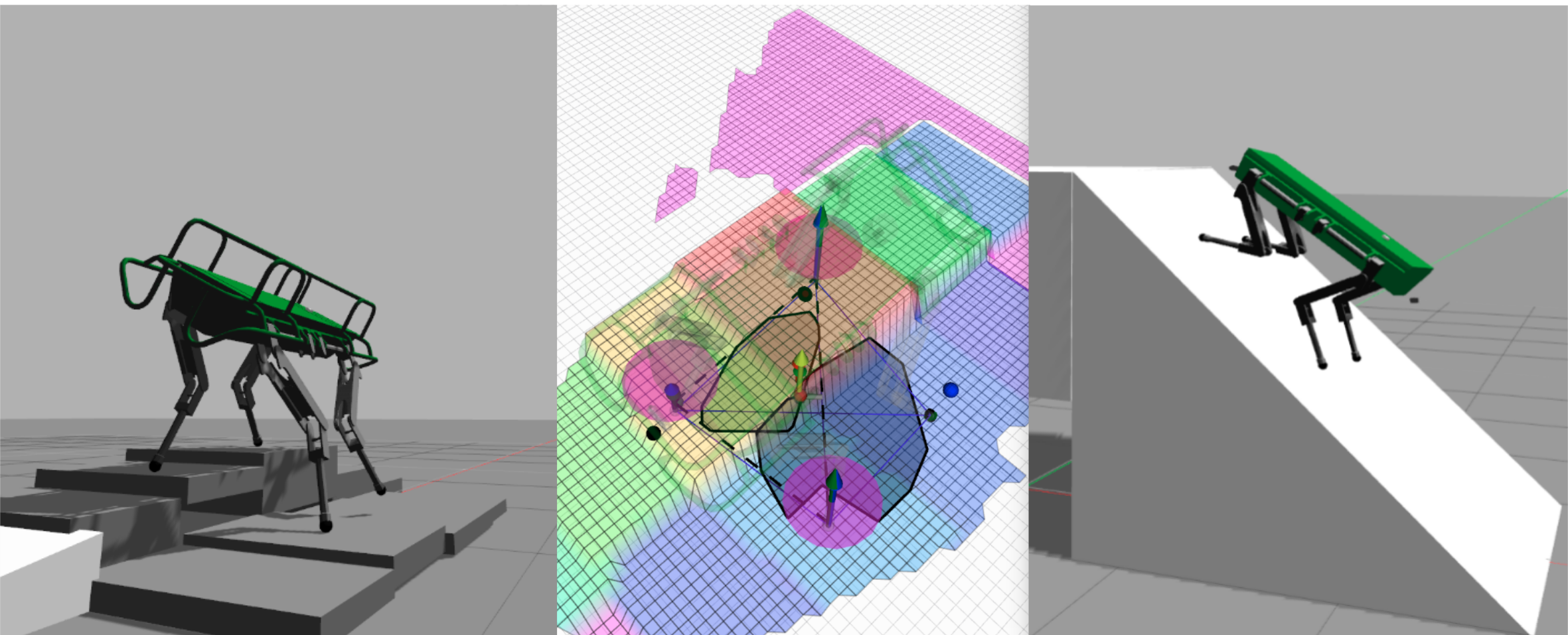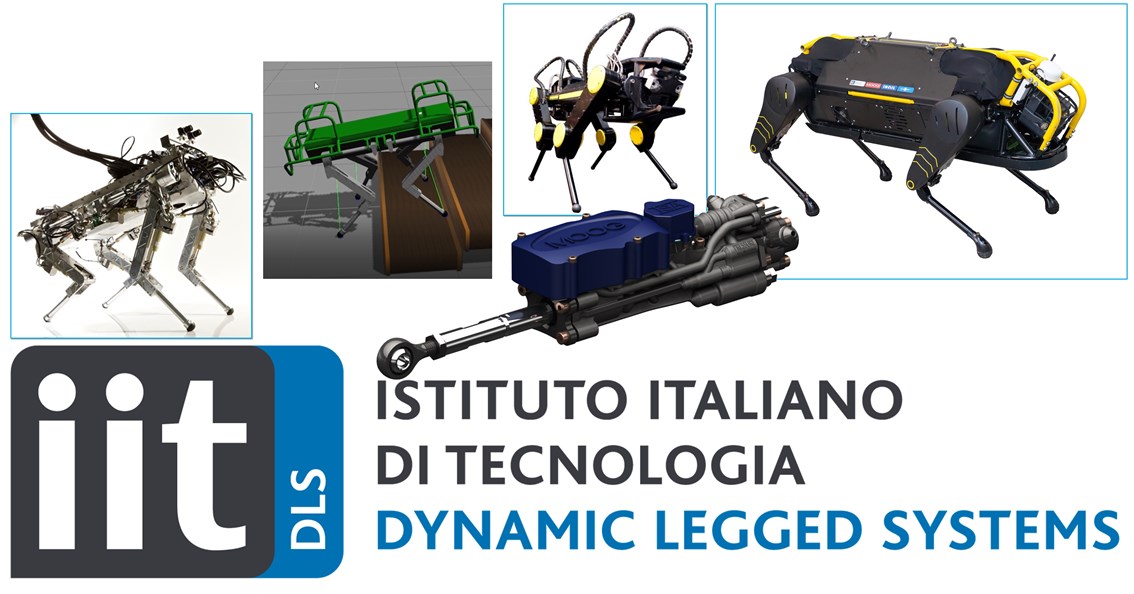This page contains our work that is be presented at ICRA 2020. Feel free to navigate through our papers' video presentation and workshop talks!
STANCE: Locomotion Adaptation over Soft Terrain
Shamel Fahmi, Michele Focchi, Andreea Radulescu, Geoff Fink, Victor Barasuol, and Claudio Semini
Whole-Body Control (WBC) has emerged as an important framework in locomotion control for legged robots. However, most WBC frameworks fail to generalize beyond rigid terrains. Legged locomotion over soft terrain is difficult due to the presence of unmodeled contact dynamics that WBCs do not account for. This introduces uncertainty in locomotion and affects the stability and performance of the system. In this paper, we propose a novel soft terrain adaptation algorithm called STANCE: Soft Terrain Adaptation and Compliance Estimation. STANCE consists of a WBC that exploits the knowledge of the terrain to generate an optimal solution that is contact consistent and an online terrain compliance estimator that provides the WBC with terrain knowledge. We validated STANCE both in simulation and experiment on the Hydraulically actuated Quadruped (HyQ) robot, and we compared it against the state of the art WBC. We demonstrated the capabilities of STANCE with multiple terrains of different compliances, aggressive maneuvers, different forward velocities, and external disturbances. STANCE allowed HyQ to adapt online to terrains with different compliances (rigid and soft) without pre-tuning. HyQ was able to successfully deal with the transition between different terrains and showed the ability to differentiate between compliances under each foot.
On the Hardware Feasibility of Nonlinear Trajectory Optimization for Legged Locomotion based on a Simplified Dynamics
Angelo Bratta, Romeo Orsolino, Michele Focchi, Victor Barasuol, Giovanni Gerardo Muscolo and Claudio Semini
Simplified models are useful to increase the computational efficiency of a motion planning algorithm, but their lack of accuracy have to be managed. We propose two feasibility constraints to be included in a Single Rigid Body Dynamics-based trajectory optimizer in order to obtain robust motions in challenging terrain. The first one finds an approximate relation-ship between joint-torque limits and admissible contact forces,without requiring the joint positions. The second one proposes a leg model to prevent leg collision with the environment. Such constraints have been included in a simplified nonlinear non-convex trajectory optimization problem. We demonstrate the feasibility of the resulting motion plans both in simulation and on the Hydraulically actuated Quadruped (HyQ) robot,considering experiments on an irregular terrain.
MPC-Based Controller with Terrain Insight for Dynamic Legged Locomotion
Octavio Villarreal, Victor Barasuol, Patrick M. Wensing, Darwin G. Caldwell, and Claudio Semini
Considering terrain morphology allows legged robots to traverse more complex scenarios. We present a novel control strategy for dynamic legged locomotion in complex scenarios that considers information about the morphology of the terrain in contexts when only on-board mapping and computation are available. The strategy is built on top of two main elements: first a contact sequence task that provides safe foothold locations based on a convolutional neural network to perform fast and continuous evaluation of the terrain in search of safe foothold locations; then a model predictive controller that considers the foothold locations given by the contact sequence task to optimize target ground reaction forces. We assess the performance of our strategy through simulations of the hydraulically actuated quadruped robot HyQReal traversing rough terrain under realistic on-board sensing and computing conditions.
Stance Control Inspired by Cerebellum Stabilizes Reflex-Based Locomotion on HyQ Robot
Gabriel Urbain, Victor Barasuol, Claudio Semini, Joni Dambre and Francis Wyffels
Advances in legged robotics are strongly rooted in animal observations. A clear illustration of this claim is the generalization of Central Pattern Generators (CPG), first identified in the cat spinal cord, to generate cyclic motion in robotic locomotion. Despite a global endorsement of this model, physiological and functional experiments in mammals have also indicated the presence of descending signals from the cerebellum, and reflex feedback from the lower limb sensory cells, that closely interact with CPGs. To this day, these interactions are not fully understood. In some studies, it was demonstrated that pure reflex-based locomotion in the absence of oscillatory signals could be achieved in realistic musculoskeletal simulation models or small compliant quadruped robots. At the same time, biological evidence has attested the functional role of the cerebellum for predictive control of balance and stance within mammals. In this paper, we promote both approaches and successfully apply reflex-based dynamic locomotion, coupled with a balance and gravity compensation mechanism, on the state-of-art HyQ robot. We discuss the importance of this stability module to ensure a correct foot lift-off and maintain a reliable gait. The robotic platform is further used to test two different architectural hypotheses inspired by the cerebellum. An analysis of experimental results demonstrates that the most biologically plausible alternative also leads to better results for robust locomotion.
Workshop on Opportunities and Challenges in Space Robotics
Michele Focchi, June 2nd 2020 at 09:00am (GMT-6:00)
Legged robots are mainly designed to traverse unstructured environments where wheeled robots have limited mobility. Their applications range from nuclear decommissioning to mining, search and rescue, inspection and surveillance. In addition, they can be applied to flank human workers (or collaborate with them) in order to reduce labor accidents, as well as in elderly care. The next generation of legged robots are envisioned to operate either autonomously or semi-autonomously (through tele-operation) over uneven terrains. This requires the rejection and compensation of disturbances, the exploitation of visual feedback, and the ability to manipulate both fragile and heavy objects. The main ingredients for legged locomotion are planning, control, perception and state estimation. Numerical optimization is a promising tool for motion planning and control for legged robotic systems in complex geometry environments (e.g. multi-contact scenarios) because it enables to push the machine up to the performance limits.
Indeed, when the complexity of the terrain increases, or when the execution of the requested task involves highly dynamic motions, numerical optimization and machine learning strategies are needed to automatically find feasible trajectories and control actions that could not otherwise be determined. In this seminar I will mainly focus on the planning aspects and on different strategies to achieve effective locomotion across complex terrain.
Workshop "Towards Real-World Deployment of Legged Robots"
Claudio Semini, July 1st 2020 at 14:00 CEST(GMT+2)
Quadruped robots for Heavy-Duty Operations